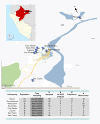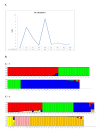Multilocus genotyping reveals high heterogeneity and strong local population structure of the Plasmodium vivax population in the Peruvian Amazon
- PMID: 20525233
- PMCID: PMC2898784
- DOI: 10.1186/1475-2875-9-151
Multilocus genotyping reveals high heterogeneity and strong local population structure of the Plasmodium vivax population in the Peruvian Amazon
Abstract
Background: Peru is one of the Latin American countries with the highest malaria burden, mainly due to Plasmodium vivax infections. However, little is known about P. vivax transmission dynamics in the Peruvian Amazon, where most malaria cases occur. The genetic diversity and population structure of P. vivax isolates collected in different communities around Iquitos city, the capital of the Peruvian Amazon, was determined.
Methods: Plasmodium vivax population structure was determined by multilocus genotyping with 16 microsatellites on 159 P. vivax infected blood samples (mono-infections) collected in four sites around Iquitos city. The population characteristics were assessed only in samples with monoclonal infections (n = 94), and the genetic diversity was determined by calculating the expected heterozygosity and allelic richness. Both linkage disequilibrium and the genetic differentiation (theta) were estimated.
Results: The proportion of polyclonal infections varied substantially by site (11% - 70%), with the expected heterozygosity ranging between 0.44 and 0.69; no haplotypes were shared between the different populations. Linkage disequilibrium was present in all populations (IAS 0.14 - 0.61) but was higher in those with fewer polyclonal infections, suggesting inbreeding and a clonal population structure. Strong population differentiation (theta = 0.45) was found and the Bayesian inference cluster analysis identified six clusters based on distinctive allele frequencies.
Conclusion: The P. vivax populations circulating in the Peruvian Amazon basin are genetically diverse, strongly differentiated and they have a low effective recombination rate. These results are in line with the low and clustered pattern of malaria transmission observed in the region around Iquitos city.
Figures


Similar articles
-
Microsatellite analysis reveals connectivity among geographically distant transmission zones of Plasmodium vivax in the Peruvian Amazon: A critical barrier to regional malaria elimination.PLoS Negl Trop Dis. 2019 Nov 11;13(11):e0007876. doi: 10.1371/journal.pntd.0007876. eCollection 2019 Nov. PLoS Negl Trop Dis. 2019. PMID: 31710604 Free PMC article.
-
Genetic Variability of Plasmodium vivax in the North Coast of Peru and the Ecuadorian Amazon Basin.Am J Trop Med Hyg. 2018 Jul;99(1):27-32. doi: 10.4269/ajtmh.17-0498. Epub 2018 May 10. Am J Trop Med Hyg. 2018. PMID: 29761758 Free PMC article.
-
Nationwide genetic surveillance of Plasmodium vivax in Papua New Guinea reveals heterogeneous transmission dynamics and routes of migration amongst subdivided populations.Infect Genet Evol. 2018 Mar;58:83-95. doi: 10.1016/j.meegid.2017.11.028. Epub 2017 Dec 5. Infect Genet Evol. 2018. PMID: 29313805
-
Uncovering the transmission dynamics of Plasmodium vivax using population genetics.Pathog Glob Health. 2015 May;109(3):142-52. doi: 10.1179/2047773215Y.0000000012. Epub 2015 Apr 18. Pathog Glob Health. 2015. PMID: 25891915 Free PMC article. Review.
-
Genetic Diversity of Plasmodium vivax Causing Epidemic Malaria in the Republic of Korea.Korean J Parasitol. 2018 Dec;56(6):545-552. doi: 10.3347/kjp.2018.56.6.545. Epub 2018 Dec 31. Korean J Parasitol. 2018. PMID: 30630274 Free PMC article. Review.
Cited by
-
Using mitochondrial genome sequences to track the origin of imported Plasmodium vivax infections diagnosed in the United States.Am J Trop Med Hyg. 2014 Jun;90(6):1102-8. doi: 10.4269/ajtmh.13-0588. Epub 2014 Mar 17. Am J Trop Med Hyg. 2014. PMID: 24639297 Free PMC article.
-
Variation in Complexity of Infection and Transmission Stability between Neighbouring Populations of Plasmodium vivax in Southern Ethiopia.PLoS One. 2015 Oct 15;10(10):e0140780. doi: 10.1371/journal.pone.0140780. eCollection 2015. PLoS One. 2015. PMID: 26468643 Free PMC article.
-
Higher microsatellite diversity in Plasmodium vivax than in sympatric Plasmodium falciparum populations in Pursat, Western Cambodia.Exp Parasitol. 2013 Jul;134(3):318-26. doi: 10.1016/j.exppara.2013.03.029. Epub 2013 Apr 4. Exp Parasitol. 2013. PMID: 23562882 Free PMC article.
-
Epidemiology of Plasmodium vivax Malaria in Peru.Am J Trop Med Hyg. 2016 Dec 28;95(6 Suppl):133-144. doi: 10.4269/ajtmh.16-0268. Epub 2016 Oct 31. Am J Trop Med Hyg. 2016. PMID: 27799639 Free PMC article.
-
The impact of sustained malaria control in the Loreto region of Peru: a retrospective, observational, spatially-varying interrupted time series analysis of the PAMAFRO program.Lancet Reg Health Am. 2023 Mar 16;20:100477. doi: 10.1016/j.lana.2023.100477. eCollection 2023 Apr. Lancet Reg Health Am. 2023. PMID: 36970494 Free PMC article.
References
-
- Mendis K, Sina BJ, Marchesini P, Carter R. The neglected burden of Plasmodium vivax malaria. Am J Trop Med Hyg. 2001;64(1-2 suppl):97–106. - PubMed
-
- Pan American Health Organization (PAHO) Malaria in the Americas: Time Series Epidemiological Data from 2000 to. http://www.paho.org/English/AD/DPC/CD/mal-reg-country-epi-data-2007.pdf (accessed 20 October 2009)
-
- Roper MH, Torres RS, Goicochea CG, Andersen EM, Guarda JS, Calampa C, Hightower AW, Magill AJ. The epidemiology of malaria in an epidemic area of the Peruvian Amazon. Am J Trop Med Hyg. 2000;62:247–256. - PubMed
-
- Branch O, Casapia WM, Gamboa DV, Hernandez JN, Alava FF, Roncal N, Alvarez E, Perez EJ, Gotuzzo E. Clustered local transmission and asymptomatic Plasmodium falciparum and Plasmodium vivax malaria infections in a recently emerged, hypoendemic Peruvian Amazon community. Malar J. 2005;4:27. doi: 10.1186/1475-2875-4-27. - DOI - PMC - PubMed
-
- Ministry of Health Peru. http://www.ins.gob.pe/vigilancia/Malaria/ESQUEMAS_TERAPEUTICOS_P.%20viva... (accessed 24, February 2010)
Publication types
MeSH terms
Substances
LinkOut - more resources
Full Text Sources

